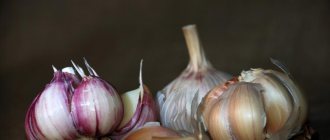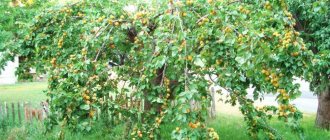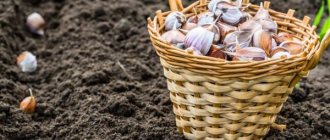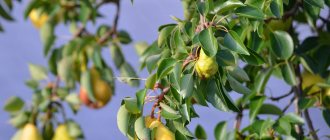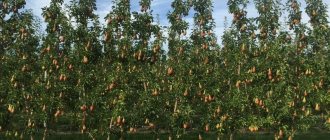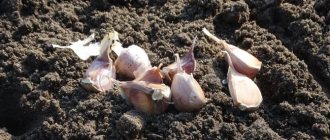Is it possible to plant pear trees in the fall? Advantages and disadvantages of autumn planting
Fruit tree seedlings are usually planted both in spring and autumn. The choice of planting time depends on the variety, weather conditions, and the desires of gardeners. Planted in the spring, trees take root throughout the season, taking root and adapting to their new location.
But experienced gardeners agree that it is still better to plant pear trees in the autumn, and there are compelling reasons for this:
- The choice of planting material in autumn is much greater than in spring.
- A high level of soil moisture allows you to reduce watering without worrying about the tree drying out.
- Rooting in moist soil and in warm weather will take place faster and better than in spring.
- Over the winter, the tree adapts to the new site and will begin to grow actively in the spring.
There are also some disadvantages to autumn planting. They are mainly related to weather and climatic conditions. Early frosts contribute to freezing of the root system and trunk of the pear tree. Too much rain, causing waterlogging of the soil, contributes to the development of root rot.
The threat of invasion by rodents and hares is higher in winter, so thorough protection of the bark of a young tree is required.
Varieties
The peculiarities of the climate of Central Russia are such that not every variety of fruit tree is suitable. Pear varieties for the Moscow region must be frost-resistant and ripen quickly, so gardeners do not recommend planting winter varieties.
Summer
Tasty and aromatic pears ripen by mid-summer and are very popular among our compatriots. When choosing a variety, pay attention to the characteristics of the plant, since most varieties require an additional pollinator.
“Lada” and “Chizhovskaya” are the best pears for the Moscow region, which complement each other. If the photo shows orchards, then these plants will definitely be there. Minimal care and resistance to common diseases will allow even a beginner to grow a garden. Delicious, aromatic fruits will become an annual gift for the owner.
Chizhovskaya pear variety
The “Cathedral” pear will delight you with high regular fertility, a strong immune system and resistance to frost. The variety is universal, so it is suitable for preservation and fresh use. Ripens by early August.
"Cosmic" is distinguished by its immunity to scab, high yield and minimal care requirements in the fall. Sweet fruits will be a great addition to the summer table. The crop ripens at the end of August. A pollinator from autumn varieties is a must.
A characteristic feature of all varieties is the short shelf life of the fruit (up to two weeks).
Pear variety Kuibyshevskaya
If you place the crop in the cold, then the pears will remain fresh for 40 days. If you need long-term preservation during early ripening, then give preference to “Chizhovskaya” and “Lada”, the fruits of which can be stored for up to 4 months.
Autumn
Tasty and aromatic fruits will delight gardeners in September and October. They are not as early ripening as summer ones, but in terms of keeping quality they are not inferior to winter varieties. All plants will make excellent pollinators for early varieties.
“Naryadnaya Efimova” is one of the most popular types of pears. Ruddy, juicy fruits beg to be taken from the photo directly to the plate. A good fertile variety with excellent taste. The only drawback was the lack of frost resistance, so special care is needed in the fall.
Conference pear variety
The “Otradnenskaya” pear begins to bear fruit in the 4th year of life and annually pleases the gardener with a bountiful harvest. Sweet fruits are recommended to be used for jam. The fruits ripen at the end of September and, if properly stored, do not lose their marketable characteristics for 120 days.
“Velesa” is a good variety, harvested in the fall. The tree is resistant to many common diseases, so minimal care is required. The huge fruits (up to 150 g) taste as good as summer pears, maintaining freshness for two months.
Growing an orchard in the Moscow region has become much easier, knowing the characteristics and needs of plants. With the correct selection of varieties and minimal care, pear seedlings develop without problems in the harsh climate of the Middle Zone.
The post How to plant pears in the fall in the Moscow region first appeared on SeloMoe.
When is it recommended to plant a pear in the fall, what is the planting time?
The time for planting should be chosen in accordance with the weather and the growing region. Planting a pear seedling must be done twenty to twenty-five days before the arrival of cold weather. It is not recommended to choose later dates, as the likelihood of soil freezing and seedling death increases.
On the day of planting, the air temperature should be above ten degrees Celsius, bright sun and wind are undesirable. Cloudy warm weather is the most favorable time.
Gardeners in the Middle Zone, Central region of Russia and the Moscow region are recommended to plant pears in September. Let's say the period from the middle of the month until the first days of October. In Siberia and the Urals, planting begins at the end of August, it is at this time that the weather is favorable for work.
In the Leningrad region, it is permissible to plant pear trees throughout the first month of autumn. But for southern gardeners, October is quite suitable.
Some professional summer residents and amateurs trust the lunar calendar. It takes into account the time of movement of the planets and highlights the most favorable and unfavorable periods for planting. The best time is considered to be the period of the waxing moon, but you can look at it in detail in the calendar itself.
You can view the lunar calendar of planting work at the link: https://kalendargoda.com/kogda-sazhat-grushi-2021-posadka-lunnyy-kalendar-vysazhivanie
Preparing seedlings for winter
The branches of a young pear can be carefully tied to the trunk of the tree so that strong winter winds and wet sticking snow cannot break them.
We tie the tree itself to a peg driven near the trunk. Some gardeners recommend tying branches of young pears to pegs with twine (each branch to a separate peg). Just like mature trees, we water the seedlings thoroughly before frost. We cover the tree trunk circles with mulch (sawdust, peat) with a layer of up to 30 cm. We shovel more snow onto the roots. But we make sure that this snow does not become covered with a crust of ice after the thaw. If this happens, you need to loosen it so that air can pass to the trunks of the seedlings. It is better to transplant seedlings in the spring, since unrooted plants may freeze or will be sick for a long time until they can recover.
Fertilizers suitable for autumn planting of pears
The pear tree prefers fertile and loose soil and grows well on loamy soil. Before planting, the area is dug up with the addition of potassium salt, superphosphate and compost. It is permissible to put sand, peat, humus, superphosphate, potassium and phosphorus mixtures in the planting hole. The use of nitrogen fertilizers during planting is excluded, since the growth of green mass during this period should be avoided. The main task of a seedling is to root and strengthen the root system.
On depleted soils, the use of rotted manure and bird droppings is allowed. It is unacceptable to use such fertilizer fresh, as it can burn the root system, as it increases the temperature when rotting.
If the soil has a clayey composition, sand, ash, and dolomite flour should be added.
How to plant a pear correctly in the fall: planting algorithm, photos and videos
Choosing a place to plant a pear tree
The choice of place to plant a pear seedling should be taken seriously. Firstly, the tree has some nuances in the choice of neighbors, and secondly, the size of an adult pear does not allow other plants to develop favorably in its shade.
Correct planting of the pear, video:
The area allocated for the pear should occupy the southern part of the garden, be windless and well lit. The pear loves the sun's rays, so the crown of the tree should not lack light.
The diameter of the crown of an adult pear exceeds five meters, so it is better to exclude possible proximity to such large trees. The pear feels comfortable close to a building or fence. The first time after planting it will be protected from wind and draft. The distance from the trunk to another tree or building is 2-3 meters.
High groundwater levels damage the root system of the pear tree, causing the development of root rot. Therefore, when planting a tree, it is necessary to study the features of the site and build a drainage system in case of proximity to groundwater.
In its neighbors, the pear prefers an apple tree and does not tolerate rowan.
Preparing a hole for planting pears
It is recommended to make a planting hole for a pear seedling in advance. When planting in autumn, it is advisable to start preparing the site in the summer. the proposed site is dug up, and six kilograms of compost, sixty grams of superphosphate and thirty grams of potassium salt are added to the soil.
The size of the planting hole is 60 cm deep, 90 cm wide.
Caring for a pear planted in autumn
Caring for a pear tree after planting consists of watering, pruning, and covering before the onset of winter.
If nutrients were added to the planting hole during planting, the plant will not require additional fertilizer.
Watering is organized once every seven to ten days, pouring three buckets of water under the root, provided there is no natural precipitation. If it rains, no watering is required to avoid waterlogging of the soil.
Protection from bright sun, rodents and frost
Don't forget about whitewashing. It is necessary not only in spring, but also in autumn, so that with the onset of the first sunny spring days the rays do not burn the bark of the trees.
- Ready-made whitewash can be purchased at the store, but you can do it yourself. To do this, we dilute one and a half kilograms of clay and two to two and a half kilograms of ordinary lime in a bucket of water. Using a brush, whiten the trunk from the lower branches to the ground. Young seedlings can be completely whitened. It is better to use a regular paint brush.
- To protect the lower parts of the trunks from rodents, they can be wrapped in spruce branches (needles down) and tied with twine.
- Next, we dig up the tree trunk circles shallowly. We water them thoroughly, then the trees will more easily withstand the approaching frosts.
- After abundant watering, cover these circles with a layer of mulch of about 15-25 cm. This can be peat or sawdust. With this coating, the roots have a better chance of remaining healthy.
- If the winter has little snow, do not forget to shovel snow onto the tree trunk during the winter.

